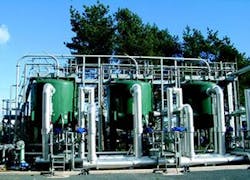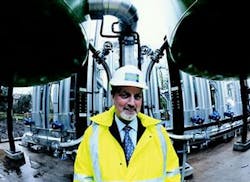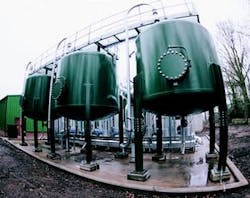UK-German venture develops arsenic-removal process
By Dr. Mike Ashley
The word "arsenic" has such a strongly emotive ring to it, with its long disreputable history of being used as a poison, that it can be more than a little disconcerting to learn that it has always occurred naturally in water supplies. It is, of course, all a question of degree. The World Health Organisation (WHO) has been keeping an eye on arsenic for many years, and finally in 1984 defined the safe upper limit of arsenic in drinking water as 0.05mg/l, with a subsequent recommendation that this should be reduced to 0.01mg/l.
Arsenic gets into water supplies by leaching from certain types of minerals, particularly from sandstone when they also contain iron compounds. The problem is seemingly distributed around the globe in a random and unpredictable way. Countries with a significant issue include Argentina, Australia, Chile, China, Hungary, India, Mexico, Peru, Thailand and the USA, but the most severe problem is currently in Bangladesh, which has received extensive press coverage.
Europe has localised problem areas, including parts of the UK, Greece, Germany, France and the Po valley in Italy. The European Community (EC) issued a directive that the 0.01mg/l WHO recommendation will be adopted as the legal limit and member states are now working towards compliance by the end of 2003.
In the UK levels of arsenic above 0.01mg/l are found mainly in the Midlands and the North West of England, with small localised issues in other parts of the country. Large utilities either abandon the source or blend with other water sources in areas with minor arsenic problems.
Severn Trent Water was not so lucky as it became clear that 17 boreholes in its area would need some treatment to guarantee compliance with the new EC directive. Severn Trent Water supplies water and sewerage services to more than three million households and businesses in the central area of England, and parts of Wales. The company scanned all available technologies looking for a standardised way of treating these water sources, which would meet all criteria of effectiveness, reliability and cost. No existing processes were found acceptable, and so in 1996 the company began its own development programme to produce a new arsenic-removal process.
Several traditional methods for removing arsenic rely on adsorption by some form of media and early work by the Severn Trent Water Technology & Development Group concentrated on testing various materials, including iron salts, carbon, manganese dioxide and activated alumina. Most success was achieved with a granulated ferric hydroxide media derived from a mined mineral source. Its arsenic-adsorption efficiency was satisfactory, but the consistency of the quality of the mineral source and the capacity of the mine to produce the large quantities potentially needed was in question.
The key breakthrough emerged when Severn Trent came to an agreement with the global chemical company Bayer AG of Germany to jointly develop the process and the media to meet the exact requirements of the water industry, not just in Europe but in the rest of the world.
SORB33trademark process
However effective the media is in adsorbing arsenic, it needs to be contained in an appropriate system if it is to work to the best advantage. The design of the SORB33 process is geared specifically to the use of the BayoxideRegistered E33 media. Both process and media were developed together to ensure that the appropriate removal efficiency would be achieved with effective use of the media and at a low overall economic cost. Bayoxide E33 media is a manufactured granular ferric oxide, which is produced under carefully controlled conditions to ensure the chemical quality and the optimum size distribution of the granules.
Initially the process was tested on a laboratory scale. The results proved promising and a full-scale demonstration plant was set up at one of the sites that had experienced the problem. The plant, at Burton Joyce, Nottingham in the UK, treats 20 ml/day of potable water and although the traces of arsenic were well below WHO safe levels, they were higher than those required by the revised EU standards.
Sampling and testing using the SORB33 process continued over the following 18 months with typical results showing a substantial reduction in arsenic levels to well below the 0.01mg/l limit. Concurrently, Bayer maintained its ongoing development of a new form of granular ferric hydroxide, and set up manufacturing facilities to ensure continuity of supply.
The two elements, comprising process design and media development, were run in parallel to ensure effective treatment as the precise design of the vessel is as important for optimum operation and long-term reliability as the nature of the media.
The SORB33 process and the Bayoxide E33 media are marketed by Severn Trent Services, a sister company of Severn Trent Water, which specialises in water treatment technology and other key services to the water industry. Key features of the process are:
• Removal of arsenic to well below the required 0.01mg/l limit.
• A simple process flowsheet with little or no flow interruptions required.
• The media has a high arsenic loading capacity with up to two years between media replacements.
• Removal of both As(III) and As(V).
• No chemical additions required for regeneration of the media.
• Spent media is "fixed" with adsorbed arsenic and is relatively easy to dispose.
• Very low residual effluent.
• Manufactured media is available in large quantities of consistent quality.
Following evaluation of the successful proving trials at the first full-size installation at Burton Joyce, an additional 15 systems have been ordered and are now under construction in the UK.
Different parameters in water specification affect the SORB33 process. Pilot plant tests should be conducted at specific sites to ensure that the most appropriate process design is selected. Severn Trent Services, which is operating several pilot installations in the USA, adopted this approach to gather detailed local performance data. This information is then fed into the process design for the full-scale plant. In addition, the original pilot plant in the UK is used for testing the effect of various unusual parameters on the process by dosing local feed water.
The first phase of SORB33 processes will soon be in full operation and further operating experience will be analysed. In addition, ongoing development work continues and Bayer AG is already producing prototype media specifications aimed at yet again increasing process efficiency, both in arsenic removal and operability of the overall process. Another key goal is increasing the extension of time between the need to change media.
Throughout development, sampling and testing has been continuous to ensure water quality. The media requires regulatory approval in most countries and approval from the Drinking Water Inspectorate (DWI) in the UK has already been received. Similar approval is currently being pursued in the key markets envisaged.
Up until recently new installations have been for public water supply, but the process and media can be adapted for point-of-use (POU) applications. The potential of this market is being explored and a licensing agreement has now been reached with US -based Apyron, a leading global supplier of POU water treatment equipment.
Development of this new system resulted from a combined effort in which the expertise from Severn Trent Services, Bayer AG and Severn Trent Water focused on finding the best solution to a difficult problem. But, in finding the answer to specific needs in the UK, we discovered a winning solution to a worldwide problem.
Author's note
Dr. Mike Ashley is the managing director of Capital Controls Ltd, part of Severn Trent Services, located in Sutton Coldfield, West Midlands, UK. For more information, contact the author at Tel: +44 121 313 2300 or Email: [email protected]




